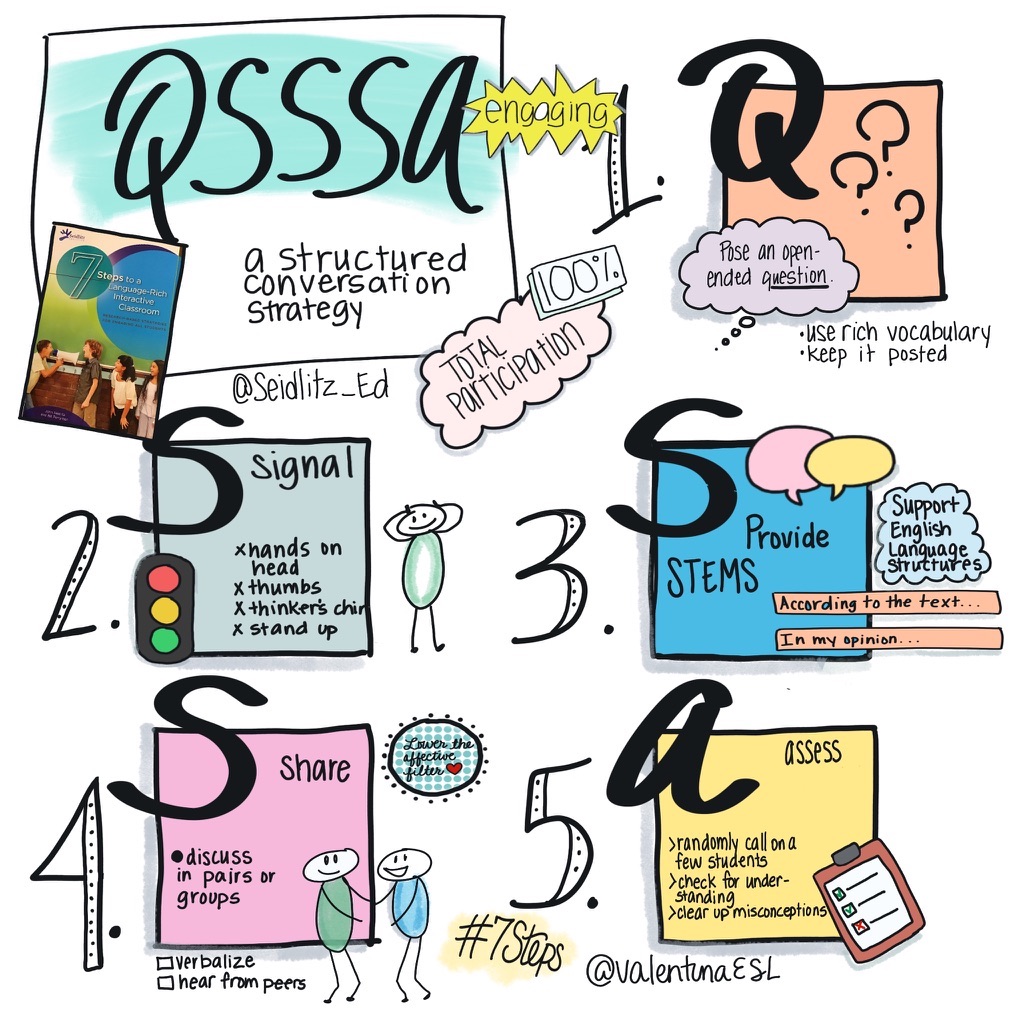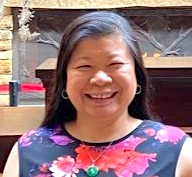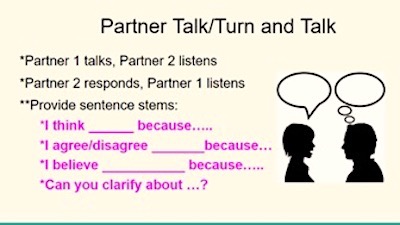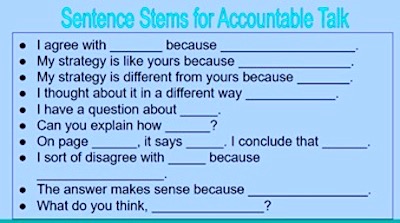Engaging MLs in Daily Academic Conversations
EL/ML education leader Jenny Vo shares four ways to engage multilingual learners in skill-building academic talk.
What is one easy strategy that educators of multilingual learners can utilize in their daily instruction to develop students’ speaking skills?
Academic conversations!
If we want our MLs to develop their speaking skills in another language, we need to provide them with authentic opportunities to participate in academic conversation and also provide them with the linguistic support they need to be comfortable and successful in the process.
How and when can we provide students with opportunities for academic discourse? Let’s talk about it!
Two types of conversation
Many teachers are afraid of noise in the classroom because they feel like they are losing control and that people who come into the classroom will think they have bad classroom management. In my early years of teaching, I thought the same thing. Didn’t you?
I felt that if my classroom was quiet with students working at their desks, then I was a teacher with great classroom management. Now, I love to hear my students’ voices as they talk to each other and share their thoughts and ideas, as they challenge each other’s thinking, forcing each other to delve deeper into the topic.
Academic conversations are sustained and purposeful conversations about school topics.” ( Zwiers & Crawford, 2011)
There are two types of talking you can have in a class – unstructured and structured. Unstructured conversation is when you don’t give the students a focus and parameters for the talk.
Unstructured conversation tends to get out of control. The students often get off task because they don’t know how long to talk and what to do when they finish talking/sharing. You end up with students who didn’t talk much, students who talked too much, and students who didn’t talk at all.
Success comes with intentional planning
Structured academic conversation is intentionally planned on the teacher’s part. It has a purpose. It has a focus. It has parameters. It is content-rich. It is sustained.
During structured academic conversations, students practice skills such as elaborating and clarifying, supporting their ideas with examples, and building on or challenging each other’s understandings. The best part of structured academic conversation is that ALL students participate.
How to structure conversation:
1. Partner Talk/Turn & Talk: The easiest way to add structured conversation to your instruction is through Partner Talk or Turn & Talk. Throughout your lesson, give students multiple opportunities to talk to each other.
When you ask the class a question, DON’T immediately call on a student to answer. Instead, give the students some thinking time and then time to share with a partner.
THEN, call on a student to share. BUT, I challenge you to keep everybody on their toes by using randomization to call on students. Randomization keeps students on their toes because they don’t know who will be called on. Consequently, ALL students are expected to have an answer ready to share.
There are several variations of Partner Talk. You can do it untimed like I described above or you can add some parameters to the process. Parameters you can set include:
- Determine who is Partner A and who is Partner B.
- Determine which partner will share first.
- Set how much time for each partner to share.
For extended and deeper discussions when I want the student to have more time to share with each other, I like to add music to the activity to get the students moving and talking to different classmates.
- Have the students stand up.
- When you turn on the music, students will move around the room.
- Once the music stops, students find the nearest person to them and high-five them.
- Then they share their thoughts with each other.
The process repeats when the music starts again. I love using this activity because students are moving and they are talking to different people besides their usual partner or the kids at their table.
2. QSSSA: The QSSSA strategy was developed and coined by John Seidlitz and Bill Perryman and described in their book (now in a 2nd edition) 7 Steps to a Language-Rich Interactive Classroom.
The QSSSA (Question, Signal, STEM, Share, Assess) is one of my favorite strategies to use for structured conversation because it gives the students thinking time, with them giving a signal to show that they are ready to share.

The other great thing about this strategy is that a sentence stem is embedded in the activity. Sentence stems are a powerful linguistic support for English learners because the stem gives them a starting point for their thoughts and response.
Sentence stems also help students formulate their responses in a sentence format, thus guiding the students into answering in complete sentences. I will touch on sentence stems a little more later.
3. Talk Read Talk Write: TRTW is a classroom process that gives students an alternate and compelling way to access content area information, and every step of the process builds academic language.
Think of TRTW as a replacement for the lecture approach. At its core, students read academic text. With a focus on the text rather than on the teacher “delivering” a lesson, students gain and deepen content understanding. “Surrounding the core text are structured opportunities to talk and write about content.” (Motley, 2016)
The best thing about the Talk Read Talk Write process is inherent in the process itself – it is structured around students learning content for their grade level subject using inquiry strategies. Teachers are able to structure the activity around the texts that students are required to read to learn targeted content. Using this process, students collaborate with each other in order to learn the content. Teachers provide the stimulus and reading material, then act as facilitators instead of lecturers.
TALK 1 is a very brief conversation, no more than 5 minutes, with the purpose of activating background knowledge, engaging the students with the topic, and setting a purpose for the reading. You can have the students respond to a visual, a question, a quote (or make it a choice). The NYT Learning Network Picture of the Day is a good source for visuals. I like using a “This or That” or “Would You Rather?” prompt to have students choose and support their choice.
During READ, students read an academic text to gain content knowledge and understanding. Reading can be structured with partners, in groups, or independently. You can assign different parts to groups and have them become the experts of each section and report back to the whole class.
During TALK 2, small groups of students will talk to each other about the reading. If you assigned expert groups for the READ portion, TALK 2 is the perfect time for representatives from each group to share their knowledge with students from other expert groups. Again, the discussion should be brief, no more than 10 minutes, with clear expectations set.
TALK 2 sets the students up for the WRITE section of TRTW, in which students share their understanding of the content in their own words on paper. Students are encouraged to use the academic vocabulary learned, write in complete sentences, and elaborate on their ideas.
Below is an example of a lesson in which both TRTW and QSSSA are incorporated. Notice that I did a read aloud instead of having the students read, just to change it up a little bit.
4. Sentence Stems: I mentioned sentence stems earlier and want to elaborate more on this essential linguistic support for our multilingual learners.
Most multilingual learners, especially your beginners and intermediate students, have difficulty formulating responses to questions. So they are reluctant to volunteer and hesitate to respond when you call on them. Providing the students with a sentence stem gives them a starting point to organize their ideas.
Sentence stems also lead students to respond in complete sentences. Because you will have multilingual learners with varying language skills in your class, provide tiered sentence stems so students can choose the ones they are more comfortable using.
I recommend posting sentence stems around the room so students may refer to them when they need to. Providing mini-sized ones for students to glue into their notebooks is also a good practice.
Academic conversation every day!
Our multilingual learners come to us with varying background knowledge and many assets to share. If we want them to succeed in learning the language and excel in the content areas, we need to provide them with linguistic support based on their individual needs.
And if we want them to develop their speaking skills while learning content (and we do!), then we should provide them with multiple opportunities to engage in academic conversation throughout the class period and day.
I strongly believe that the strategies I share above – the different variations of Partner Talk, the QSSSA, Talk Read Talk Write,and Sentence Stems – will help your multilinguals develop their oral language at a pace that may surprise you!
References
Motley, N. (2016). Talk Read Talk Write: A practical approach to learning in the secondary classroom, 2nd edition. Seidlitz Education.
Seidlitz, J. & Perryman, B. (2022). 7 Steps to a Language-Rich Interactive Classroom. Seidlitz Education.
Zwiers, J. & Crawford, M. (2011). Academic Conversations: Classroom Talk That Fosters Critical Thinking and Content Understandings. Routledge/Stenhouse Publishers. Also see: Next Steps with Academic Conversations (2019).
Jenny Vo (@JennyVo15) is the EL Director for International Leadership of Texas, a free public charter school network serving more than 21,000 K-12 students at 20 campuses in the Dallas-Fort Worth, Houston, and College Station areas. She earned her B.A. in English from Rice University and her M.Ed. in educational leadership from Lamar University. Jenny has worked with multilingual learners during all of her 25+ years in education and was previously the ESL ISST in Katy (TX) ISD. She is a past president of TexTESOL IV.

































